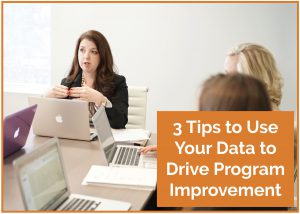According to the National Student Clearinghouse, only about half of college students nationwide actually complete their degrees. The statistics are even worse for those starting at community colleges or 2-year programs. This results in many students accruing debt without gaining the financial benefits of a college degree. Additionally, colleges lose money when students drop out, highlighting the need for program improvement to create better outcomes for both students and institutions. It’s a lose-lose situation that calls for change.

Colleges have been getting increasing pressure from the federal government and others to improve their college completion rates. They have turned to data analytics to better understand how they could intervene earlier with students who might be at risk of not completing their degree and dropping out.
When I first heard this podcast from The Hechinger Report on how “Colleges are using big data to track students in an effort to boost graduation rates, but it comes at a cost” it made me want to listen closer. As a #datalover and #datanerd, this topic certainly peaked my interest. I am also a first generation college graduate and can personally relate to this topic of college dropouts since many (over half) of my high school peers didn’t finish their college degree.
This is not a new strategy (“predictive analytics”) as companies like Amazon and Google are doing this all of the time with our digital footprint. However, it’s new for colleges and non-profit organizations.
Georgia State is a case study example of how their university has embraced data analytics to improve college completion rates. Their university now has one of the highest rates of college graduation for public universities in the country, and they have closed the racial equity gap. Students of color are graduating at the same rate as white students at Georgia State.
So how did Georgia State get there? They used their data to drive and inform program improvement. We’ve talked about this here and here.
The podcast also shares the struggles that other universities face in implementing these changes. It’s not enough to purchase the data analysis software, but you also need trained staff who are able to analyze and interpret the data to take action on it.
We’ve put together 3 tips to get started with using your data to drive program improvement that’s not only based off of the success of Georgia State but our work with other clients who want to improve their impact.
- Have a system in place to collect and track meaningful data. Georgia purchased a data system to help them bring all of their data together and identify patterns. At Transform Consulting Group (TCG) we are big fans of using Tableau Software (see more here and here). We love Tableau, because it can make your data easier to review and understand. We are also adept at using whatever data systems our client has to pull out the information that we need to inform decision-making.
- Have trained staff who can analyze and interpret the data. Getting the data from your system is the first step. Then you need to have individuals who know how to identify patterns, ask inquisitive questions and develop recommendations. We are big fans of forming an “Impact Team” at an organization who is trained on analyzing and reviewing your data and can help drive action based on the results. Learn more here.
- Have a process to determine program improvement changes. Once you have your data and results, you are now at the fun part – you get to take action on changes to make to improve your results! We find that sometimes organizations don’t have a clear process in place to determine what changes – such as a new curriculum, staff training, client outreach – they will make based on the results. We follow a Continuous Quality Improvement Process using the “Plan – Do – Study -Act or (PDSA)” framework to determine what action steps we will take. Other similar processes might be “Lean/Six Sigma”. At Georgia State they decided to hire additional advisors to use the data to reach out to students at risk. This is one of the many changes they have made, based on their data results, to help students stay on track with college graduation. The goal here is to be intentional on how you will use your data to make programmatic changes and then study the result of those changes to know if it’s working or not.
What are some goals that you are not currently satisfied within your organization? Have you considered how data analytics could help you focus in on improving your results? Bill Gates said, “Without measurement there is no shared accountability.“ We would love to help you improve your impact through data analytics. Contact us to learn more.

